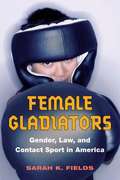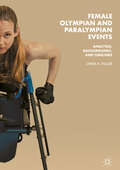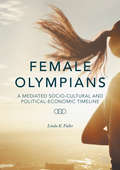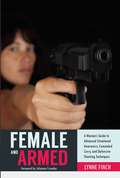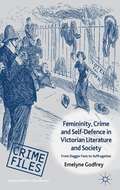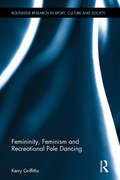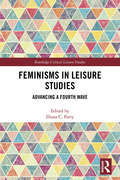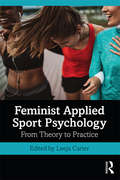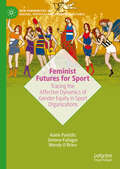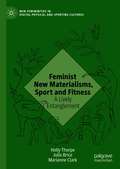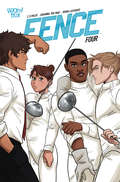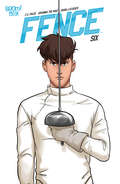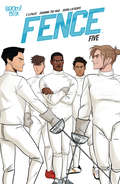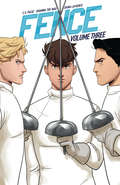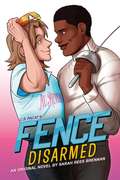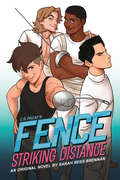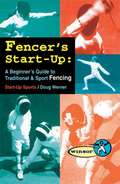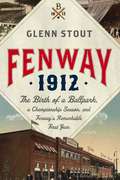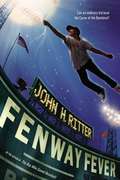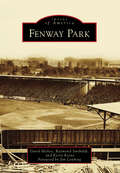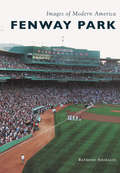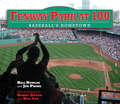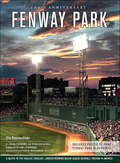- Table View
- List View
Female Gladiators: Gender, Law, and Contact Sport in America
by Sarah K. FieldsFemale Gladiators examines the legal and social history of the right of women to participate with men in contact sports. The impetus to begin legal proceedings was the 1972 enactment of Title IX, which prohibited discrimination in educational settings, but it was the Equal Protection Clause of the U.S. Constitution and the equal rights amendments of state constitutions that ultimately opened doors. Despite court rulings, however, many in American society resisted--and continue to resist--allowing girls in dugouts and other spaces traditionally defined as male territories. When the leagues continued to bar girls simply because they were not boys, the girls went to court. Sarah K. Fields examines the legal and cultural conflicts over gender and contact sports that continue to rage today.
Female Olympian and Paralympian Events: Analyses, Backgrounds, and Timelines
by Linda K. FullerFemale Olympian and Paralympian Events is a groundbreaking book that examines women’s sports in the Olympic and Paralympic Games, which have long been underappreciated and under-analyzed. The book begins with a brief background on women’s participation in the Olympic Games and their role relative to the International Olympic Committee, then introduces the underlying Gendered Critical Discourse Analysis theory used throughout the book’s analysis before delving into a literature review of female Olympians and Paralympians’ events. It includes a listing of noteworthy “firsts” in the field, followed by individual discussions of twenty-eight Summer and seven Winter events, analyzed according to their historical, rhetorical, and popular cultural representations. Women’s unique role(s) in the various events are discussed, particular athletes and Paralympic events are highlighted, and original tables are also included. At the end of each section, affiliated organizations and resources are included in this invaluable referential volume.
Female Olympians
by Linda K. FullerThis book examines women's participation in the Olympic Games since they were allowed to be included in that global arena. Using a holistic, social scientific approach, and emphasizing the rhetoric of sport mediatization, Female Olympians reviews the literature relative to sexism, racism, and ageism before providing historical, political, economic, and socio-cultural perspectives such as the gendered language of Olympic reportage, religious considerations, women's bodies relative to their training for the Games, drugs and doping, and female Paralympians. With numerous critical case studies, never-before assembled data, and personal interviews with athletes, this volume offers insights that both investigate and celebrate female Olympians' successes.
Female and Armed: A Woman?s Guide to Advanced Situational Awareness, Concealed Carry, and Defensive Shooting Techniques
by Lynne Finch Julianna CrowderIn Female and Armed Lynne Finch offers an information-packed follow-up to her first book, Taking Your First Shot. Based on questions and requests from readers, this book addresses more advanced techniques for personal defense as well as range drills to help readers practice and hone those skills. It’s important to know how to defend yourself, and Finch provides the building blocks necessary to successfully navigate some dangerous, real-life scenarios. Be it a carjacking, robbery, or home invasion, readers will learn how to protect themselves and their family. Female and Armed introduces readers to more advanced situational awareness techniques and builds upon their previous shooting experience by teaching them how to responsibly handle and carry a concealed handgun. Finch covers the advances in female holsters and discusses the various ways to carry, as well as the importance of having a primary carry method. In addition to this, topics include handgun retention, defensive draw stroke and defensive reloading, shooting from an unstable platform, and shooting from within a car. Knowing how to handle yourself can make all the difference in a stressful and dangerous situation. This guide also includes defensive tactics when confronted by an assailant armed with a gun or knife. Brimming with full-color photos, this approachable guide is written in Finch’s distinctive conversational and nonthreatening style. It is great for the novice shooter looking to advance and for the more experienced shooter looking for tips to improve her shooting.
Femininity, Crime and Self-Defence in Victorian Literature and Society
by Emelyne GodfreyThis exploration into the development of women's self-defence from 1850 to 1914 features major writers, including H. G. Wells, Elizabeth Robins and Richard Marsh, and encompasses an unusually wide-ranging number of subjects from hatpin crimes to the development of martial arts for women.
Femininity, Feminism and Recreational Pole Dancing (Routledge Research in Sport, Culture and Society)
by Kerry GriffithsThis book explores the phenomenon of pole dancing as an increasingly popular fitness and leisure activity for women. It moves beyond previous debates surrounding the empowering or degrading nature of pole dancing classes, and instead explores the complexities of these concepts and highlights that women participating in this practice cannot be seen as one dimensional. Femininity, Feminism and Recreational Pole Dancing explores the construction, negotiation and presentation of a gendered and classed identity and self through participation in pole dancing, the meaning of pole dancing as a fitness practice for women, and the concepts of community and friendship as developed through classes. Using empirical research, the book uncovers the stories and experiences of the women who participate in these classes, and examines what the mainstreaming of this type of sexualised dance means for the women who practice it. Pole dancing is shown to be a practice in which female identities are negotiated, performed and enacted and this book positions pole dancing as an activity which both reinforces but also presents some challenge to ideas of feminism and femininity for the women that participate. Women's participation in pole dancing is described in a discourse of choice and control, yet this book argues that the decision to participate is somewhat constructed by the advertising of these classes as enabling women to create a particular desirable self, which is perpetuated throughout our culture as the 'ideal'. Exploring the ways in which women attempt to manage impressions and present themselves as 'respectable', the book examines how women wish to dis-identify with both women who work as strippers and women who are feminist, seeing both identities as contradictory to the feminine image that they pursue. The book explores the capacity of these classes to offer women some feelings of agency but challenges the idea that participating in pole dancing can offer collective empowerment. The book ultimately argues that women's participation can be viewed both in terms of their active engagement and enjoyment of these classes and in terms of the structures and pressures which continue to shape their lives. This timely publication explores the complexity of the pole dancing phenomenon and highlights a range of questions surrounding this activity as a leisure form. It will be a valuable contribution to those interested in women's and gender studies, cultural studies, feminism, sociology and leisure studies.
Feminisms in Leisure Studies: Advancing a Fourth Wave (Routledge Critical Leisure Studies)
by Diana ParryFeminisms in Leisure Studies acknowledges and advances the contribution of feminist theories to leisure knowledge and research. Building upon the strong history of feminist leisure scholarship, the book reviews key feminist theories and offers an overview of a fourth wave of feminism and its relevance to leisure. Written by a team of leading international feminist scholars, each chapter addresses a particular theoretical perspective, using examples from each author’s research to unpack methodological and substantive issues essential to leisure studies. Critically, this book moves beyond women, the emphasis of much gender scholarship to date, to focus on issues of feminism as connected to leisure scholarship more broadly. This book is an important and engaging read for students and scholars of diversity, women’s studies, multiculturalism, social justice, gender studies, leisure studies, LGBTQQ studies, and feminist research.
Feminist Applied Sport Psychology: From Theory to Practice
by Leeja CarterWith an emphasis on women and transwomen athletes and exercisers of color, Feminist Applied Sport Psychology: From Theory to Practice introduces the reader to feminist, black feminist, and womanist sport psychology, offering an alternative and powerful approach to working with athletes. Covering core concepts, applied skills, and research methods, the book includes useful features throughout, such as discussion questions and definitions of key terms. It is organized into three sections covering, firstly, feminist theory, history, movements, and their importance in applied sport psychology; secondly, the intersection of race, class, and gender, and the integration of intersectional considerations into sport psychology; and finally, in-depth case studies of feminist sport psychology in action, each of which offers strategies for best practice. Feminist Applied Sport Psychology: From Theory to Practice is important reading for feminist-centred students and practitioners in performance and sports domains, and exercise psychology and anybody with an interest in feminist approaches to working with women of diverse backgrounds.
Feminist Futures for Sport: Tracing the Affective Dynamics of Gender Equity in Sport Organizations (New Femininities in Digital, Physical and Sporting Cultures)
by Simone Fullagar Adele Pavlidis Wendy O'BrienThis book examines the historical present as a turning point for women who are moving into traditional masculine cultures of team contact sports. The authors investigate how shifting gender dynamics are reshaping sports practices, organisations, and representations. They ask: What happens when women’s sporting bodies enter spaces that have historically excluded them? How is this change embodied, experienced, and navigated by athletes, stakeholders, and organizations within the broader sports ecosystem? And how does resistance to gender equality manifest in different forms? Exploring how the challenge of gender inequity materialises through the relations and actions that are transforming sport organisations in complex ways, the book suggests that change must be translated in time and space, recognising the global and local forces that shape the sociomateriality of sport practices, organisations and assemblages. The pursuit of gender equity in sport as a political, economic and cultural phenomenon, raises key questions about how ‘value’, ‘markets’, ‘space’ and ‘time’ materialise through gendered formations. In this way the authors articulate a feminist future of sport for the present.
Feminist New Materialisms, Sport and Fitness: A Lively Entanglement (New Femininities in Digital, Physical and Sporting Cultures)
by Holly Thorpe Julie Brice Marianne ClarkThis book offers the first critical examination of the contributions of feminist new materialist thought to the study of sport, fitness, and physical culture. Bringing feminist new materialist theory into a lively dialogue with sport studies, it highlights the possibilities and challenges of engaging with posthumanist and new materialist theories. With empirical examples and pedagogical offerings woven throughout, the book makes complex new materialist concepts and theories highly accessible. It vividly illustrates sporting matter as lively, vital, and agentic. Engaging specifically with the methodological, theoretical, ethical and political challenges of feminist new materialisms, it elaborates understandings of moving bodies and their entanglements with human, non-human, technological, biological, cultural, and environmental forces in contemporary society. This book extends humanist, representationalist, and discursive approaches that have characterized the landscape of critical research on active bodies, and invites new imaginings and articulations for sport and moving bodies in uncertain times and unknown futures.View the video abstracts for each of the book's chapter here: Chapter 1 https://www.youtube.com/watch?v=3UQy7aq1k20&list=PLdbxSLlj0ri04cOHxK37TfaQg0IAv6Znf&index=1 Chapter 2 https://www.youtube.com/watch?v=yM-Q4FmW6h8&list=PLdbxSLlj0ri04cOHxK37TfaQg0IAv6Znf&index=2 Chapter 3 https://www.youtube.com/watch?v=D0VxosyyrKg&list=PLdbxSLlj0ri04cOHxK37TfaQg0IAv6Znf&index=3 Chapter 4 https://www.youtube.com/watch?v=eN9b58fPISA&list=PLdbxSLlj0ri04cOHxK37TfaQg0IAv6Znf&index=4 Chapter 5 https://www.youtube.com/watch?v=GM3Ss_Tz0ZY&list=PLdbxSLlj0ri04cOHxK37TfaQg0IAv6Znf&index=5 Chapter 6 https://www.youtube.com/watch?v=pNbSBThlR6s&list=PLdbxSLlj0ri04cOHxK37TfaQg0IAv6Znf&index=6 Chapter 7 https://www.youtube.com/watch?v=NFRAGwH8UOY&list=PLdbxSLlj0ri04cOHxK37TfaQg0IAv6Znf&index=7
Femoroacetabular Impingement
by Óliver Marín-PeñaThis book is the first monograph to examine all aspects of femoroacetabular impingement (FAI), an important disease first described early in the twenty-first century. Comprising 27 chapters and including many color illustrations, the book contains a variety of points of view from more than 50 experts from 11 countries and represents an up-to-date compilation of professional knowledge on FAI. The full range of available surgical treatments is carefully described and evaluated, including arthroscopic treatment, the open and mini-open approaches, periacetabular osteotomy, hip resurfacing arthroplasty, and combined techniques. Differential diagnosis, imaging, postoperative management, and treatment outcome are also discussed in appropriate detail. It is hoped that this book will promote a comprehensive approach to what is a common pathology and thereby encourage further improvement in treatment.
Fence #4: Rivals (Fence #4)
by C. S. Pacat Johanna The Mad Joana LafuenteNicholas begins to overthink everything as he struggles to prove he deserves his place at Kings Row.
Fence #6 (Fence #6)
by C. S. Pacat Johanna The Mad Joana LafuenteAfter an unexpected defeat, tensions run high among the fencers of Kings Row. <P><P><i>Advisory: Bookshare has learned that this book offers only partial accessibility. We have kept it in the collection because it is useful for some of our members. To explore further access options with us, please contact us through the Book Quality link. Benetech is actively working on projects to improve accessibility issues such as these.</i>
Fence (Fence #5)
by C. S. Pacat Johanna The Mad Joana LafuenteSeiji’s calm is badly rattled over a lost match and his mysterious past begins to come out.
Fence Vol. 2 (Fence #2)
by C. S. Pacat Johanna The Mad Joana LafuenteTryouts are well underway at King’s Row for a spot on the prodigious fencing team, and scrappy fencer Nicholas isn’t sure he’s going to make the grade in the face of surly upperclassmen, nearly impossibly odds, and his seemingly unstoppable roommate, the surly, sullen Seiji Katayama. It’ll take more than sheer determination to overcome a challenge this big! From the superstar team of C.S. Pacat (The Captive Prince) and fan-favorite artist Johanna the Mad comes the second volume of this acclaimed, dynamic series.
Fence Vol. 3 (Fence #3)
by C. S. PacatFrom the superstar team of C.S. Pacat (The Captive Prince) and fan-favorite artist Johanna the Mad comes the third volume of this acclaimed, dynamic series.
Fence: Disarmed
by Sarah Rees BrennanThe boys of Kings Row head to France with exes, rivalries, and secrets in this fun and hilarious novel by a New York Times bestselling author—inspired by the award-nominated comic series by C.S. Pacat and Johanna The Mad.The boys of Kings Row are off to a training camp in Europe! Surrounded impressive scenery and even more impressive European fencing teams, underdog Nicholas can't help but feel out of place. With the help of a local legend, though, he and the rest of the team finds it within themselves to face superior fencers, ex-boyfriends, expulsion, and even Nicholas's golden-boy, secret half-brother, the infamous Jesse Coste. Will Aiden and Harvard end up together, though? En garde!The second installment of this enticing original YA novel series by Sarah Rees Brennan, rich with casual diversity and queer self-discovery, explores never-before-seen drama inspired by C.S. Pacat's critically acclaimed Fence comic series.Text and Illustration copyright: © 2021 BOOM! StudiosFence(TM) and © 2021 C.S. Pacat
Fence: Striking Distance
by Sarah Rees BrennanThe boys of Kings Row bout with drama, rivalry, and romance in this original YA novel by The New York Times bestselling author Sarah Rees Brennan -- inspired by the award-nominated comic series by C.S. Pacat and Johanna The Mad.Sixteen-year-old Nicholas Cox is the illegitimate son of a retired fencing champion who dreams of getting the proper training he could never afford. After earning a place on the elite Kings Row fencing team, Nicholas must prove himself to his rival, Seiji Katayma, and navigate the clashes, friendships, and relationships between his teammates on the road to state championships -- where Nicholas might finally have the chance to spar with his golden-boy half-brother.Coach Williams decides to take advantage of the boys' morale after a recent victory and assigns them a course of team building exercises to further deepen their bonds. It takes a shoplifting scandal, a couple of moonlit forest strolls, several hilariously bad dates, and a whole lot of introspection for the team to realize they are stronger together than they could ever be apart. The first installment of this enticing original YA novel series by Sarah Rees Brennan, rich with casual diversity and queer self-discovery, explores never-before-seen drama inspired by C.S. Pacat's critically acclaimed Fence comic series and boasts original cover and interior art by Johanna The Mad.Text and Illustration copyright: © 2020 BOOM! StudiosFence(TM) and © 2020 C.S. Pacat
Fencer's Start-Up: A Beginner's Guide to Traditional and Sport Fencing
by Doug WernerLearn fencing and get a great workout, improve hand-eye coordination, and just plain have fun. Endorsed by Veteran Fencers Quarterly.
Fenway 1912: The Birth of a Ballpark, a Championship Season, and Fenway's Remarkable First Year
by Glenn Stout"After one hundred years, each time you walk up the ramp from beneath the stands and out toward that sea of sunlit grass, Fenway Park remains the most special kind of place there is, a place that can still change your life."In anticipation of the one hundredth anniversary of America's most beloved ballpark, the untold story of how Fenway Park came to be and its remarkable first season. 1912 was a leap year, the year the Titanic sank, and it was also the year baseball's original shrine, the one and only Fenway Park, was born. While the paint was still drying, the infield grass still coming in, the Red Sox embarked on an unlikely season that culminated in a World Series battle against the Giants that stands as one of the greatest ever played.Fenway 1912 tells the incredible story of Fenway, from the unorthodox blueprint that underlies the park's notorious quirks, to the long winter when locals poured concrete and erected history, to the notorious fixers who then ruled the game, to the ragtag team who delivered a world championship, Fenway's first.For all that has been written in tribute to the great Fenway Park, no one has ever really told the behind-the-scenes true story of its tumultuous yet glorious first year. Drawing on extensive new research, the esteemed baseball historian Glenn Stout delivers an extraordinary tale of innovation, desperation, and perspiration - capturing Fenway as never before.
Fenway Fever
by John H. RitterHappy 100th Birthday, Fenway Park!"Stats" Pagano may have been born with a heart defect, but he lives for three things: his family's hot dog stand right outside fabled Fenway Park, his beloved Red Sox, and any baseball statistic imaginable. When the family can no longer make ends meet with the hot dog stand, life becomes worrisome for Stats. Then the Sox go on a long losing streak and the team's ace pitcher--and Stats's idol--becomes convinced the famed Curse of the Bambino has returned. Stats just has to help . . . but how? As the Sox faithful sour on their team, Stats forms a plan that ultimately unifies an entire city and proves that true loyalty has a magic all its own. In honor of Fenway Park's 100th birthday, baseball novelist John H. Ritter delivers an inspiring tale for the sports fan in each of us, regardless of team allegiance. .
Fenway Park (Images of America)
by David Hickey Kerry Keene Raymond Sinibaldi Jim LonborgFive days after the sinking of the Titanic, Boston's Fenway Park held its grand opening. Since that day, millions have witnessed the Red Sox play baseball. Their "Royal Rooters" evolved into the "Fenway Faithful" and are now commonly referred to as "Red Sox Nation." Nine World Series have been staged upon Fenway's turf, along with three Major League All-Star Games. Aside from baseball, Fenway has been host to professional and amateur football games, ice hockey, basketball, soccer, lacrosse, hurling, boxing and wrestling matches, and even a circus. Music from concerts has reverberated across its lawn, religious services have been held, and political rallies staged--all adding patches to the quilt of Fenway's rich, illustrious history. The structure that noted author John Updike referred to many decades ago as "a lyric little band box" has become one of New England's most beloved historical landmarks.
Fenway Park (Images of Modern America)
by Raymond SinibaldiIn June 1967, Red Sox owner Tom Yawkey declared Fenway Park outdated and stated that without help from the city for a new ballpark, he would consider moving his team. That same year, an impossible dream came true as the 100-1 underdog Red Sox won the pennant and a record-setting 1.7 million fans visited Fenway. Since then, approximately 110 million fans have watched the Red Sox play at what is now called "America's Most Beloved Ballpark." While Fenway Park was once known for simply resembling a warehouse, its nearby streets now hold a baseball festival every game. Those festivals have grown to include concerts, hockey, soccer, and high school football. The exterior walls of the park extoll the accomplishments of each Red Sox World Championship team and fly the banners of Red Sox Hall of Famers since the team's birth in 1901. Red Sox bronzed immortals stand watch at the entrance to Gate B.
Fenway Park at 100
by Jim Prime Bill Nowlin Bobby DoerrOn April 20, 1912, The Boston Red Sox played their first official game at Fenway Park. 27,000 fans were on hand to witness the Red Sox defeat the rival New York Highlanders--later known as the Yankees--7-6 in 11 innings. It was an event that may have made front page news in Boston had it not been for the sinking of the Titanic five days earlier.Since that day, the oddly-shaped stadium at 4 Yawkey Way has played host to nearly 8,000 Red Sox games, including fifty-five in the postseason, launching the legends of Tris Speaker, Jimmie Foxx, Ted Williams, Carl Yastrzemski, Jim Rice, Wade Boggs, and Pedro Martinez, and making the ballpark a worldwide destination for legions of baseball fans in the process.From the Green Monster to Pesky's Pole, The Triangle to the lone red seat marking the longest home run ever hit in the stadium (a 502-foot blast off the bat of Ted Williams in 1946), Fenway Park's unique charms have captivated generations of sports fans.100 Years of Fenway Park tells through vivid, full-color photographs and illuminating prose, the story of the most cherished American stadium, creating an endearing portrait of a building whose rich history resonates in the hearts and minds of the Red Sox vast fanbase. With a special foreword by Red Sox legend Carl Yastrzemski, this is a book that no Red Sox fan should be without.
Fenway Park: A Salute to the Coolest, Cruelest, Longest-Running Major League Baseball Stadium in America
by John Powers Ron DriscollFenway Park. The name evokes a team and a sport that have become more synonymous with a cityOCOs identity than any stadium or arena in the country. aSince opening in the same week of 1912 that the Titanic sank, the parkOCOs instantly recognizable confines have seen some of the most dramatic happenings in baseball history, including Carlton FiskOCOs OC Is it fair?OCO home run in the 1975 World Series and Ted WilliamsOCOs perfectly scripted long ball in his final at-bat. For 100 years, the Fenway faithful have been tested. They have known triumph and heartbreak, miracles and cursesOCowell, one curse in particularOCoto such a degree that an entire nation of fans heaved a collective sigh of relief when Dave Roberts stole a base by a fingertip in 2004, triggering the most amazing comeback in the gameOCOs annals. aTo sit and watch a game at Fenway is to recognize that the pitcher is standing on the same mound where Walter Johnson, Christy Mathewson, and Babe Ruth pitched, that a hitter is in the same batterOCOs box where Ty Cobb and Hank Aaron and Shoeless Joe Jackson dug in to take their swings. This is a ballpark that has embraced its odd construction quirks, including the bizarre triangle out in center field and the Green Monster that looms above the left fielder, and todayOCofor better and for worseOCoit remains largely unchanged from the day it opened. In its long history, Fenway has hosted football, hockey, soccer, boxing, and so much more. It has provided a backdrop to hundreds of historic events having nothing to do with sports, including concerts, religious gatherings, and political rallies. It was the site of Franklin Delano RooseveltOCOs final campaign address, as well as visits by music luminaries from Stevie Wonder to Bruce Springsteen to the Rolling Stones. aThrough it all, the Boston Globe has been the consistent, respected chronicler of every important moment in park history. In fact, the newspaper played a remarkable role in FenwayOCOs creation and evolution: the Taylor familyOCofounders and longtime owners of the GlobeOCoowned the ballclub in 1912, helped finance the new stadium, and renamed the team the OC Red SoxOCO. It is the GlobeOCOs insider perspective, combined with more than a century of exemplary journalism, that makes this book the definitive narrative history of both park and team, and a centennial collectorsOCO item unlike any other. Its pages offer a level of detail that is unmatched, with exceptional writing and hundreds of rarely seen photographs and illustrations. This is Fenway Park, the complete story, unfiltered and expertly told. "
